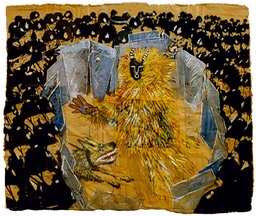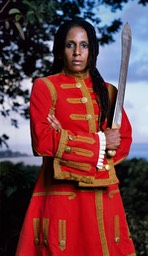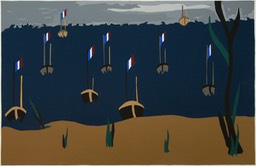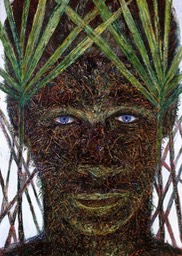PAMM’s ‘Caribbean: Crossroads of the World’ exhibit is tumultuous, thought-provoking
BY GEORGE FISHMAN
SPECIAL TO THE MIAMI HERALD
04/20/14
Audio
Hear Elvis Fuentes on post-modernism: bitly.com/ElvisFuentesPostmodernism
Hear Diana Nawi on the installation process: bitly.com/DianaNawiInstallation
Hear Emily Mello on the Akuzuru performance: bitly.com/EmilyMelloPerformance
Hear Marc Latamie on his new work: bitly.com/MarcLatamie
Caribbean: Crossroads of the World floods the exhibition spaces of the Pérez Art Museum Miami with a potent and multifarious selection of 180 objects, bearing both clear and obscure connections to the Caribbean. Works in an encyclopedic range of styles, mediums and themes embody fundamental currents of history, social forces, geography and economics. And what better place than Miami to expose them? As curator Elvis Fuentes says, “Miami is a Caribbean city; there’s no question about it.”
However, the exhibition originated in New York, where it was organized and exhibited concurrently in El Museo del Barrio, the Queens Museum of Art and the Studio Museum in Harlem in 2012. It took years to research and assemble, under the direction of Fuentes and his curatorial team.
“Migrating” to Miami entailed a major reconfiguration with significant input from PAMM’s staff. “We decided to focus more on how the many themes and many issues have been dealt with by contemporary artists, including artists living in Miami,” Fuentes said.
PAMM associate curator Diana Nawi provided essential local support. “One of the things that we were very cognizant of is that we have a collection here that’s our primary resource,” Navi said. “It’s the backbone of our institution, and within that collection, of course, there are exceptional examples of Miami-based artists.”
Among them, Fuentes noted: “We have a work by Edouard Duval-Carrié that is a portrait of Toussaint Louverture, the leader of the Haitian Revolution, and that work is in dialogue with work by Jacob Lawrence. It, of course, coincides with Edouard’s solo show. On the other hand, we have a work by Glexis Novoa that features the view that is actually seen from the museum itself.”
Nawi emphasized the museum’s goal of eliciting community discussions. And they will arise: This show is not a tourism brochure.
To organize so much history, so many nations, geographies, traditions and identities, the exhibition is divided into four themes, Nawi said.
Fluid Motions “deals with the reality of living in or on the water,” Nawi said. “The Caribbean derives its name from the Caribbean Sea, and these are islands. And so, by and large, water defines everything, whether it’s a means to open trade or whether it’s a means to remain isolated.”
Martinique-born artist Marc Latamie said people think water is isolating, but every island is also a port. “We have a history in the Caribbean to be part of Africa with a mix of Europe and also of the continent where we are today.” His sculptural installation consists of several 50-pound sacks of sugar, a commercial scale and neon text that poetically alludes to the global exchange of ideas and commodities. And it’s a piece created in and for Miami, just days before the opening.
The exhibition starts with images of water, and aquatic themes abound. Miamian Julio Larraz’s painting of a sinister submarine — Pablo Escobar’s drug vessel? — dwarfs Joseph Nacius’ Boat People next to it, carved in relief and crowded with passengers. Rigaud Benoit’s elegantly seductive Sirena, with her retinue of fish and accoutrements of Haitian Voudou practice, is comfortably accompanied by a chisel-cut steel mermaid by Gabriel Bien-Amié. Regina José Galindo’s nearby video, Grave, shows men throwing sacks into the waves, where they sink to the ocean floor. “What do you think they contain?” That was PAMM chief curator Tobias Ostrander’s provocative reference to the suspicious activity. Water often symbolizes purity, but not always.
Poetry and grace return in Yeni y Nan’s video, in which the pioneering performance artists immersed their nude bodies in the shoreline salt deposits of Venezuela.
Dramatic conflict is captured in African-American artist Jacob Lawrence’s silkscreen Flotilla, which shows Napoleon’s fleet, attempting to quell the rebellion that led to Haiti’s celebrated independence. Nearby, Renée Cox portrays herself — proudly wearing a red British uniform and brandishing a machete — as Queen Nanny, a leader of the fiercely independent Maroons, escaped slave communities of 18th century Jamaica.
Among the preconceptions explored and upended is that of Caribbean artists as unschooled, naïve and unsophisticated. “The Caribbean was post-modern even before post-modernity was a word, because the whole idea of the cannibalism and appropriation of different cultures has been part of the Caribbean since the very onset,” Fuentes said. “So, we think of the syncretic processes that all the Afro-Caribbean religions underwent. It’s really very similar to the whole idea of post-modernity, where you have coexisting images, symbols that are re-signified and used in a very different way.”
The Shades of History theme threads a twisted course through African culture, racial identity and the issues of trade, economy and slavery. Skin color and hair embody conflicted views of beauty. As Fuentes notes, “In many cases, of course, it has to do with race. Ebony Patterson deals with the idea of beauty and how it has impacted the popular culture in Jamaica, in particular. She is presenting Untitled Species I on the dancehall culture and the issue of skin bleaching as an image of the beautiful in what I call the economies of ‘the look.’ ”
Patterson’s striking mixed-media work features mottled skin, bling, hot lips, ambiguous gender, Victorian patterning and sparkle-masked eyes.
Another complex theme, Counterpoints, “deals with the economy, both historic, looking at slavery, plantations, the tobacco and sugar industries and then moving into the present, where we’re talking very much about issues of tourism, ecology, contemporary economies around cultural production,” Nawi said.
The Caribbean is a region, like Miami, that’s promoted as a kind of paradise. According to Nawi, “Miami … is an overly imagined city, and it occupies a lot of fantasy landscape for people. And so, I think, that’s something that very much ties us to the Caribbean reality and that artists have taken on.”
Agostino Brunias, for example, was hired by a British planter to portray island life. His Linen Market, Dominica, circa 1780, depicts a picturesque and decorous scene with many light-skinned women. Fuentes calls this “a whitewashed image of the island, and you will see there are no social conflicts; no conflicts of any kind.”
Reversing course, we find Dominica-born Tam Joseph, who lives in London. His 1988 Spirit of the Carnival spotlights the harsh reception of a Caribbean tradition revived in the United Kingdom. The annual Notting Hill carnival is represented by a raffia-costumed, black-masked dancer, surrounded by a phalanx of black-uniformed policemen, bearing shields. A snarling dog lunges into the inner circle, but is held at bay by the unfazed celebrant.
“It speaks about the criminalization in the press and also by the authorities of those popular celebrations,” Fuentes said.
The last theme is Kingdoms of this World, which takes on issues of spirituality, cultural production, religion and Carnival.
Each theme includes works both historical and contemporary. Could a few pieces have been pared to create a more focused show? Yes, but only with great difficulty.
The iconic, multisensory explosion of Carnival is challenging to convey with static images, but the curators have included Rigaud Benoit’s surrealistic Flower Carnival, plus costumes and designs; also a surprising video by Los Carpinteros and a major collateral performance program.
Thursday’s celebratory opening of the exhibition will feature dramatic performances on two evenings by Trinidadian artist Akuzuru. PAMM’s deputy director of education, Emily Mello, said that Trance-Formations begins with a procession that includes two horses and 12 dancers. It takes place outside the museum, and then dancers will move inside. “Many of the themes also reference fertility movements from various spiritual practices, but it is in an art context and it is performance art at the same time, drawing from those traditions.” Besides the symposium, free daily free tours and artist talks are planned. A Caribbean video series and other public events will run during the summer.
While not part of the Caribbean exhibition, Guyanese artist Hew Locke’s commissioned work suspended in the lobby is intimately linked. For Those in Peril on the Sea revisits the prayerful tradition of votive boats hanging in churches to protect seafarers.
The immensely appealing sculpture, a regular backdrop for “selfies,” has considerable local relevance. Among the boats is an improvised raft, like those used by desperate balseros to flee Cuba.
In a video prepared for PAMM, the artist explained, “Basically the whole thing is about making global links between people on the sea. Some of them, as the title says, in peril, and some of them going about their daily business.”
Much as Miami is a global portal of people and ideas, Locke’s sculpture is emblematic of the locale, the museum and this tumultuous exhibition. The multiple narratives and perspectives, fearless broaching of taboos, wide historical span and startling twists of sensual and intellectual imagination constitute a real treasure. Miamians will realize how little they know of their own region, and even “islanders” will make uplifting and disturbing discoveries about what they think of as home.
IF YOU GO
What: ‘Caribbean: Crossroads Of The World’
When: Through Aug. 17
Where: Pérez Art Museum Miami, 1103 Biscayne Blvd., Miami
Info: 305-375-3000; info@pamm.org; pamm.org
Related events
• Opening celebration 6-10 p.m. Thursday includes performance by Akuzuru: ‘TRANCE-FORMATIONS — Body Aphorisms’; 7-8 p.m.
• Performance by Akuzuru: ‘TRANCE-FORMATIONS — The Knowing’; 4:30-5:30 p.m. Friday.
• Caribbean Crossroads Symposium: Transnational Histories; 1:30-8:30 p.m. Friday and 11 a.m.- 4 p.m. Saturday



